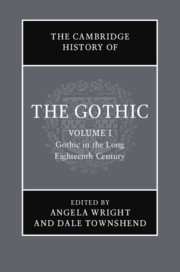Book contents
- The Cambridge History of the Gothic
- The Cambridge History of the Gothic
- The Cambridge History of the Gothic
- Copyright page
- Contents
- Illustrations and Captions for Volume I
- Notes on Contributors
- Acknowledgements
- Introduction: The Gothic in/and History
- 1.1 The Goths in Ancient History
- 1.2 The Term ‘Gothic’ in the Long Eighteenth Century, 1680‒1800
- 1.3 The Literary Gothic Before Horace Walpole’s The Castle of Otranto
- 1.4 Gothic Revival Architecture Before Horace Walpole’s Strawberry Hill
- 1.5 Horace Walpole and the Gothic
- 1.6 Shakespeare’s Gothic Transmigrations
- 1.7 Reassessing the Gothic/Classical Relationship
- 1.8 ‘A World of Bad Spirits’: The Terrors of Eighteenth-Century Empire
- 1.9 In Their Blood: The Eighteenth-Century Gothic Stage
- 1.10 Domestic Gothic Writing after Horace Walpole and before Ann Radcliffe
- 1.11 Early British Gothic and the American Revolution
- 1.12 Gothic and the French Revolution, 1789–1804
- 1.13 The Aesthetics of Terror and Horror: A Genealogy
- 1.14 Ann Radcliffe and Matthew Lewis
- 1.15 The Gothic Novel Beyond Radcliffe and Lewis
- 1.16 Oriental Gothic: Imperial-Commercial Nightmares from the Eighteenth Century to the Romantic Period
- 1.17 The German ‘School’ of Horrors: A Pharmacology of the Gothic
- 1.18 Gothic and the History of Sexuality
- 1.19 Gothic Art and Gothic Culture in the Romantic Era
- 1.20 Time in the Gothic
- Select Bibliography
- Index
1.10 - Domestic Gothic Writing after Horace Walpole and before Ann Radcliffe
Published online by Cambridge University Press: 16 July 2020
- The Cambridge History of the Gothic
- The Cambridge History of the Gothic
- The Cambridge History of the Gothic
- Copyright page
- Contents
- Illustrations and Captions for Volume I
- Notes on Contributors
- Acknowledgements
- Introduction: The Gothic in/and History
- 1.1 The Goths in Ancient History
- 1.2 The Term ‘Gothic’ in the Long Eighteenth Century, 1680‒1800
- 1.3 The Literary Gothic Before Horace Walpole’s The Castle of Otranto
- 1.4 Gothic Revival Architecture Before Horace Walpole’s Strawberry Hill
- 1.5 Horace Walpole and the Gothic
- 1.6 Shakespeare’s Gothic Transmigrations
- 1.7 Reassessing the Gothic/Classical Relationship
- 1.8 ‘A World of Bad Spirits’: The Terrors of Eighteenth-Century Empire
- 1.9 In Their Blood: The Eighteenth-Century Gothic Stage
- 1.10 Domestic Gothic Writing after Horace Walpole and before Ann Radcliffe
- 1.11 Early British Gothic and the American Revolution
- 1.12 Gothic and the French Revolution, 1789–1804
- 1.13 The Aesthetics of Terror and Horror: A Genealogy
- 1.14 Ann Radcliffe and Matthew Lewis
- 1.15 The Gothic Novel Beyond Radcliffe and Lewis
- 1.16 Oriental Gothic: Imperial-Commercial Nightmares from the Eighteenth Century to the Romantic Period
- 1.17 The German ‘School’ of Horrors: A Pharmacology of the Gothic
- 1.18 Gothic and the History of Sexuality
- 1.19 Gothic Art and Gothic Culture in the Romantic Era
- 1.20 Time in the Gothic
- Select Bibliography
- Index
Summary
This chapter focuses on an often overlooked aspect of the history of Gothic writing: the important works that appeared between the publication of Horace Walpole’s The Castle of Otranto in 1764–5 and that of Ann Radcliffe’s The Castles of Athlin and Dunbayne in 1789. These decades saw the publication of a rich and diverse range of Gothic-marked texts. Novels by Sophia Lee, Clara Reeve, Charlotte Smith and James White are considered in relation to the writing of less well-known authors such as Anne Fuller, Martha Harley, Harriet Meziere, Mr Nicholson and Thomas Sedgwick Whalley, as well as anonymously published work. While acknowledging the variety of approaches, styles and attitudes encompassed by such writing, the chapter demonstrates that, in the 1770s and 1780s, the Gothic is overwhelmingly associated with domestic, British settings. Such domestic Gothic writing also parallels the home and the nation, so that the stories of individuals reflect on national character. This first wave of Gothic texts aims to supplement and interrogate non-imaginative approaches to the nation’s past, participating in a sustained re-examination of British history and identity.
Keywords
- Type
- Chapter
- Information
- The Cambridge History of the GothicVolume 1: Gothic in the Long Eighteenth Century, pp. 222 - 242Publisher: Cambridge University PressPrint publication year: 2020



